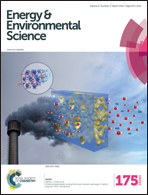Determination of the exciton binding energy and effective masses for methylammonium and formamidinium lead tri-halide perovskite semiconductors†
Abstract
The family of organic–inorganic halide perovskite materials has generated tremendous interest in the field of photovoltaics due to their high power conversion efficiencies. There has been intensive development of cells based on the archetypal methylammonium (MA) and recently introduced formamidinium (FA) materials, however, there is still considerable controversy over their fundamental electronic properties. Two of the most important parameters are the binding energy of the exciton (R*) and its reduced effective mass μ. Here we present extensive magneto optical studies of Cl assisted grown MAPbI3 as well as MAPbBr3 and the FA based materials FAPbI3 and FAPbBr3. We fit the excitonic states as a hydrogenic atom in magnetic field and the Landau levels for free carriers to give R* and μ. The values of the exciton binding energy are in the range 14–25 meV in the low temperature phase and fall considerably at higher temperatures for the tri-iodides, consistent with free carrier behaviour in all devices made from these materials. Both R* and μ increase approximately proportionally to the band gap, and the mass values, 0.09–0.117m0, are consistent with a simple k.p perturbation approach to the band structure which can be generalized to predict values for the effective mass and binding energy for other members of this perovskite family of materials.


 Please wait while we load your content...
Please wait while we load your content...